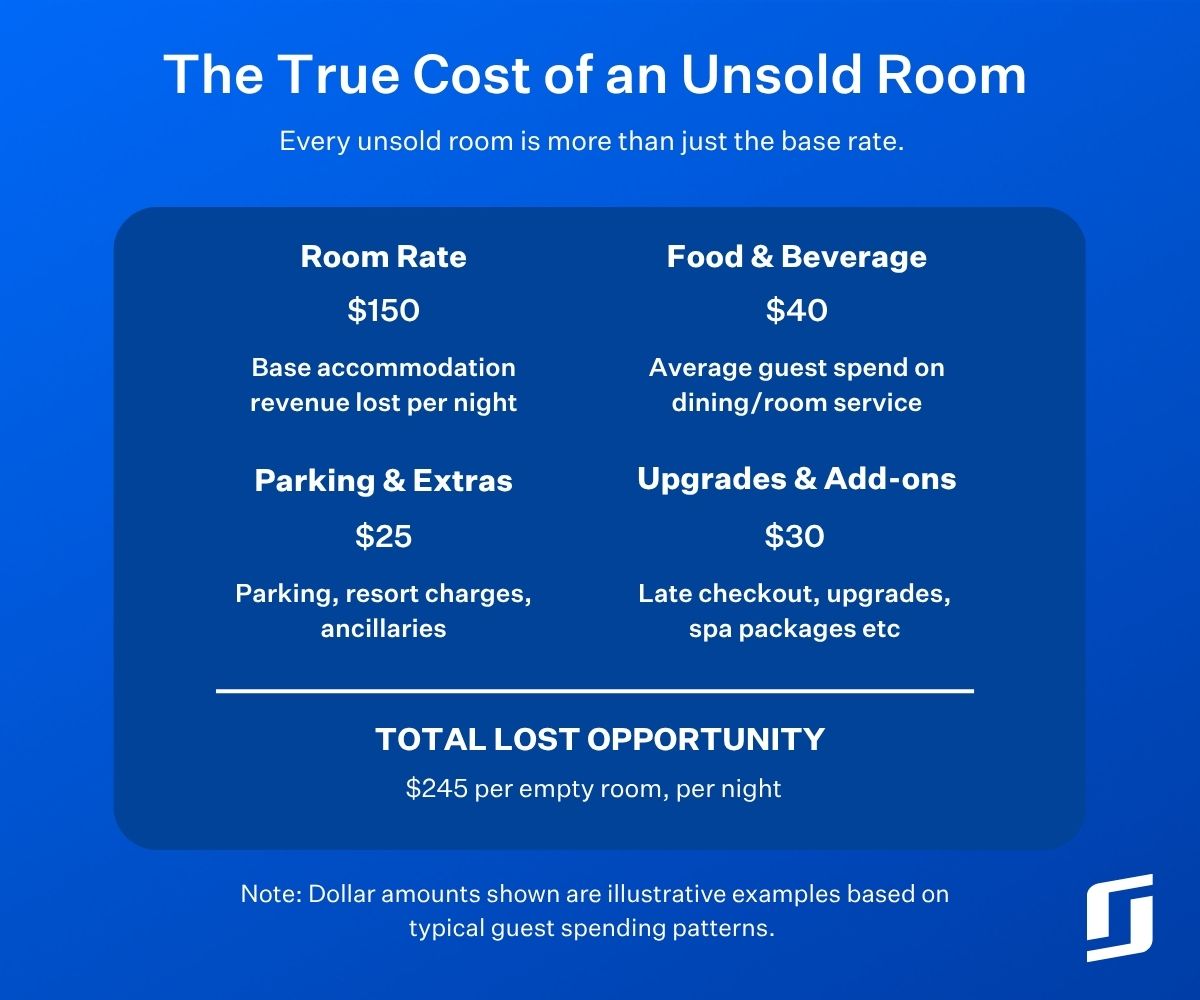What does it mean when a hotel has unsold rooms?
Unsold rooms are room nights left empty once the stay date has passed, meaning the revenue is gone for good. In hotel terms, they’re classed as perishable inventory because you can’t reclaim the value once the clock ticks past midnight.
Unsold rooms aren’t the same as those you’ve closed for maintenance or set aside for housekeeping. They’re fully available rooms that didn’t get booked, often because demand didn’t show up, rates weren’t adjusted in time, or distribution wasn’t wide enough.
The economics make this sting even more. Fixed costs such as staffing and utilities don’t change much night to night, while the marginal cost of selling one more room is usually low. That’s why an empty $0 room is often worse than a discounted one, as long as the discount is managed carefully to avoid hurting long-term rate positioning. For example, if your ADR target is $150 and 10 rooms stay unsold, that’s $1,500 gone in a single night, before factoring in add-ons.
It’s incredibly important to have a specific strategy for dealing with upcoming unsold rooms and distressed inventory.
Table of contents
Why is it important to have a strategy for unsold inventory?
Every unsold room represents permanent lost revenue, which makes it critical to have a plan for managing vacancies. A clear strategy helps hotels protect profit, smooth out demand swings, and make the most of every sellable night.
A room that goes empty doesn’t just lose its rate value. It also loses the secondary revenue that guests might have spent in your restaurant, on parking, or at the bar.

When you treat unsold rooms as a recurring challenge and generate a repeatable strategy accordingly, rather than a one-off issue, you can plan for the patterns. Shoulder seasons, weekdays with weak pickup, and event cancellations all create gaps. Hotels that react only when the rooms are already empty miss the chance to shift demand earlier with packages, local partnerships, or targeted offers.
A proactive approach also reduces stress on your team. Without a framework, staff are left scrambling with last-minute discounts that may damage rate integrity. With one in place, you can define which levers to pull, which channels to use, and when to act. That gives consistency across properties and builds confidence that vacancies can be managed without panic.
Stay ahead with real-time pricing intelligence Get daily pricing recommendations and market alerts delivered to your mobile, so you can instantly capture every revenue opportunity.
How do hotels typically manage unsold rooms?
Hotels often manage unsold rooms by lowering rates, pushing last-minute deals through online travel agents (OTAs), or offering packages that bundle extras to boost appeal. These tactics can fill vacancies, but they’re usually reactive and don’t always protect long-term revenue goals.
The most common approach is discounting through OTAs. By dropping prices close to the stay date, hotels can increase visibility and capture late demand. While this can generate quick sales, it also cuts into profit margins and may train guests to wait for discounts rather than booking earlier.
Another strategy is packaging unsold rooms with meals, spa access, or tickets to local attractions. Bundling helps maintain perceived value while shifting occupancy, especially during shoulder periods. Hotels also lean on opaque distribution channels such as Hotwire or Priceline, where guests book without knowing the brand until after purchase. These channels move inventory without directly undercutting public rates.
Corporate contracts and group business sometimes play a role too. If blocks haven’t been picked up, releasing them back into general inventory can help fill the gap. Similarly, loyalty programme promotions and flash sales can stimulate demand quickly, though they require careful timing to avoid undermining rate integrity.
Some properties also experiment with alternative uses for unsold rooms, like renting them for the day to remote workers or selling short-stay packages. These aren’t yet mainstream across the industry, but they’re gaining traction as hotels look for ways to get more value out of empty space.
Key takeaways
- Reactive discounting fills rooms quickly but trains guests to wait for deals and erodes profit margins over time.
- Value-preserving tactics like bundling or opaque channels protect rate integrity while still moving distressed inventory.
- Alternative monetisation models (day rentals, workspace use, flash loyalty offers) are gaining traction as hotels look beyond traditional overnight stays.
Connect with the world’s leading OTAs
SiteMinder gives you unprecedented reach to global and regional markets with real-time online distribution to online travel agencies (OTAs).
Learn More
What are creative ways to profitably use unsold rooms?
Creative strategies for unsold rooms go beyond discounting. Hotels can repurpose empty spaces as day-use rooms, private work areas, dining venues, or even barter assets. These approaches help generate value while protecting rate integrity and strengthening community ties.
The scale of the opportunity:
- Roughly one-third of hotel rooms go unsold every night, making vacancies one of the biggest sources of lost revenue in the industry.
- Unsold rooms are classed as perishable assets, meaning once the night has passed the revenue is permanently lost.
- Dynamic pricing can increase bookings by about 25% and RevPAR by 20%, showing that proactive strategies can turn distressed inventory into measurable income.
Day-use rooms
Selling rooms for part of the day is a growing trend. Travellers on layovers, remote workers, or locals seeking a quiet break are willing to pay for a few hours of comfort. Platforms like Dayuse.com make it easier to reach this audience and monetise rooms that might otherwise sit empty until evening.
Private work space
With hybrid work here to stay, hotels can market unsold rooms as temporary offices. High-speed internet, privacy, and in-room amenities create a compelling alternative to crowded cafés or co-working spaces. This not only drives revenue but also introduces new guests to your property.
Private dining
Restaurants are often limited in capacity, so offering a guest room as an intimate private dining space can appeal to couples, small groups, or business meetings. Pairing the room with a curated menu or bottle service transforms a vacant space into a premium experience.
Bartering
Unsold rooms don’t always need to be sold for cash. Hotels can trade them with local businesses for services, marketing exposure, or staff perks. This preserves cash flow while creating valuable partnerships that may lead to future bookings.
Photography or film studio
Vacant rooms can double as backdrops for photographers, videographers, or content creators. From lifestyle shoots to product photography, hotels can earn income by renting spaces for creative use. This also generates free exposure when content is shared online.
Key takeaways:
- Alternative revenue models don’t compete with overnight rates – they fill gaps traditional bookings miss.
- Cash and non-cash approaches work together: direct income from rentals, indirect value from barter and exposure.
- The strongest strategies introduce new guest segments (remote workers, content creators, diners) who might become overnight guests later.
What are the best tools to optimise unsold inventory?
The right tools help hotels respond quickly when rooms risk going unsold. Platforms designed for distribution, pricing, and last-minute sales make it easier to capture late demand, protect rate integrity, and turn empty rooms into revenue.
Hotels typically lean on a mix of revenue management systems, last-minute booking apps, and channel managers to keep inventory moving. These tools automate tasks that would otherwise overwhelm staff, such as adjusting rates across multiple OTAs, releasing unused group blocks, or surfacing same-day availability to mobile travellers. Without them, properties often end up relying on manual discounting, which erodes profitability and consistency across sites.
- SiteMinder: A centralised platform that connects your PMS with OTAs, metasearch, and booking engines. It automates real-time rate and availability updates across channels, helping hotels fill last-minute gaps without double-bookings.
- HotelTonight: Built on the insight that around one-third of hotel rooms go unsold nightly, this app connects travellers looking for same-day deals with hotels wanting to move distressed inventory.
- Hotwire and Priceline: Opaque pricing channels that let hotels sell unsold rooms without showing the brand name upfront. This helps move inventory without visibly undercutting public rates.
- RoomRaccoon: An all-in-one hotel management system designed for independents and smaller chains. It combines PMS, booking engine, and channel manager features, which makes it easier to optimise availability at short notice.
- Dayuse.com: A specialist platform for day-use bookings, allowing hotels to monetise rooms that would otherwise sit empty until evening check-in.
FAQs on unsold hotel rooms
How to get a room when a hotel is sold out?
Even if a property shows as sold out online, it’s worth calling the front desk directly. Hotels sometimes hold back a small number of rooms for walk-ins, VIPs, or last-minute cancellations. Loyalty programme members may also get access to inventory not listed publicly.
Do last-minute hotel deals still exist?
Yes, last-minute deals are still widely available through apps like HotelTonight, OTAs, and opaque booking channels such as Hotwire or Priceline. These platforms specialise in filling distressed inventory that would otherwise go unsold.
Do hotel rooms get cheaper closer to the date?
Rates sometimes drop on the day of arrival if occupancy is lower than expected, but this isn’t guaranteed. Many hotels now use dynamic pricing, which means rates adjust in real time based on demand. Depending on the market, prices can rise just as easily as they fall.


